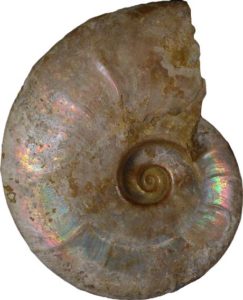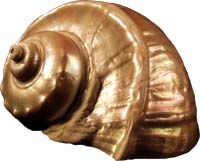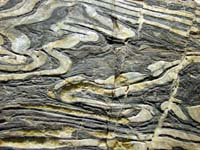Main fields
 Fossils
Fossils
Evidence of petrified animals and plants
Ranges from unicellular organisms to dinosaurs
About 40000 specimens
| Cretaceous ammonites (Lehmann) |
| Inclusions in Baltic amber |
| Tertiary molluscs (Kuster-Wendenburg u.a.) |
| Otoliths (Menzel) |
 Modern molluscs
Modern molluscs
Shells of modern mussels, snails and squids
Ranges from the escargot to the giant clam
About 25000 specimens
This term includes shells of modern mussels, snails and squids that live in modern oceans, on the continent as well as in rivers and lakes. Consequently, these specimens have to be placed into the field of zoology. This part of the Geosciences Collection is particularly comprehensive, with several thousand species. This goes from the giant clam Tridacna, with valves that are more than 1 m in length, to the buoyancy organs of small-sized squids with flimsy calcareous tests. The molluscs were collected around the world, this goes from intensive green land-snails from China to colourful cowrys from the South Seas. In this context the particular trade connections of Bremen all over the world were important, since this brought valuable material already in historic time into the hanseatic city. It would not be possible to collect many specimens again, since the collection includes specimes of animals that have become rare and are protected today. Furthermore the shells in the collection were built at times with no pollution in the environment and no significant amounts of harmful substances present in the sea respectively the vegetation on the continent, thus they can be compared to shells from todays habitats. The zoology collection is grouped on the basis of systematics, that means into groups of animals and plants.
| Door snails, Clausilids (Von dem Busch) |
| Chinese land snails (Schmacker) |
| Land snails, achatinellids, from Hawai (William Dell Hartman) |
 Minerals and rocks
Minerals and rocks
Crystals and rock samples
Ranges from the iron ore to the diamant
About 15000 specimens
Minerals are homogeneous constituent parts of the Earth’s crust and occur as crystals. The Geosciences Collection houses particularly well-crystallised examples of minerals as well as numerous rocks. A rock is a mixture of minerals. This ranges from rocks that were formed in a liquid magma (magmatic rock) to rocks that were transformed under pressure and/or temperature (metamorphic rock), to depositional rocks (sediments), including a collection on stratigraphy. The collection of minerals is sorted by classes, based on the chemistry of crystals. The stratigraphy is ordered by the series (epochs) of the Earth’s history and also contains some specimens with palaeontological objects. The petrography is sorted by groups of rocks, that means into sediments, magmatites and metamorphites. The oldest specimen is a rock that is more than half a meter in length and 3.5 billion years old. This itabirite consists of reddish-brownish and black layers of iron ore that are alternating with light bands of quartz and reflect the presence of oxygen-producing organisms in the sea.
| Geschiebes (Alfons P. Meyer and others) |
| Large gem crystals (Gwinner) |
